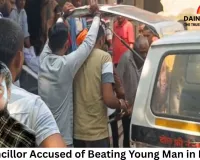Historic Surrender in Chhattisgarh: 208 Naxalites Lay Down Arms in Largest Maoist Surrender
Digital Desk
1.jpg)
In a landmark development marking a significant breakthrough in India's fight against left-wing extremism, 208 Naxalites surrendered in Chhattisgarh's Bastar region on Friday, October 17, 2025, bringing down weapons and embracing mainstream society in what is being described as the largest-ever Maoist surrender in the state's history.
The mass surrender ceremony took place at the Reserve Police Lines in Jagdalpur, where the former insurgents arrived holding copies of the Indian Constitution, symbolizing their commitment to democratic values and a new beginning. The group comprised 110 women and 98 men, representing various ranks of the outlawed CPI (Maoist) organization.
High-Profile Surrenders and Weapons Haul
Among those who laid down arms was Rupesh alias Satish (also known as Asanna), a Central Committee Member and intelligence chief of the Maoist military wing, along with four Dandakaranya Special Zonal Committee (DKSZC) members, one Regional Committee member, 21 Divisional Committee Members, and 61 Area Committee Members. The surrendered cadres deposited 153 weapons, including 19 AK-47 rifles, 17 SLR rifles, 23 INSAS rifles, one INSAS light machine gun, 36 .303 rifles, four carbines, and 11 barrel grenade launchers.
DGP's Statement: Foundation of Naxalism Destroyed
Addressing the historic surrender, Chhattisgarh DGP Arun Dev Gautam emphasized that the ideological foundation of Naxalism has collapsed in the region. "Naxalite organizations kept misleading youth by claiming they were fighting for the people of Bastar. But they have now realized that they were not fighting for the people; they were causing harm to them," DGP Gautam stated.
He highlighted that Bastar's lack of development over decades was a direct consequence of Naxal activities. "For so many years, Bastar did not develop. Now, if everyone contributes together, Bastar will progress. It's not just about strategy anymore—the very foundation has been eliminated," the DGP added.
Abujhmad and North Bastar Declared Naxal-Free
With this mass surrender, officials declared that most of Abujhmad and North Bastar have been freed from Naxal influence, ending decades of Red terror in the region. Union Home Minister Amit Shah announced on Thursday that Abujhmad and North Bastar, once considered impregnable Maoist strongholds, are now largely free from Naxal terror, with only South Bastar remaining affected.
"This is a landmark day in the country's battle against Naxalism," Shah declared, adding that the menace is now "breathing its last". The Home Minister has set March 2026 as the deadline for completely eradicating Naxalism from India.
Government's Rehabilitation Policy Yields Results
Officials attributed the unprecedented surrender to the success of the government's Naxal Eradication and Rehabilitation Policy 2025, which combines development initiatives, dialogue, and trust-building measures to encourage militants to return to mainstream society. The surrendered cadres were accorded a symbolic red carpet welcome, with each receiving a copy of the Indian Constitution and a rose during the formal ceremony called 'Puna Margem'—signifying a new life through rehabilitation.
Impressive Track Record in Anti-Naxal Operations
Over the last 22 months under the BJP government, Chhattisgarh has witnessed remarkable progress in its anti-Naxal campaign, with 477 Naxalites neutralized, 1,785 arrested, and 2,110 surrendered. This recent mass surrender follows another significant development earlier this week when 78 cadres surrendered in Sukma, Kanker, and Kondagaon districts, and 61 Naxalites laid down arms in Maharashtra's Gadchiroli district.
The sustained offensive by security forces, establishment of over 65 new camps in Bastar including previously inaccessible areas like Abujhmad, and the government's comprehensive approach combining security operations with development initiatives have collectively contributed to dismantling the Naxal infrastructure in the region.
This historic surrender represents a decisive turning point in Chhattisgarh's long battle against left-wing extremism, bringing hope for lasting peace and development in the Bastar region.

1.jpg)

.jpg)
1.jpg)






